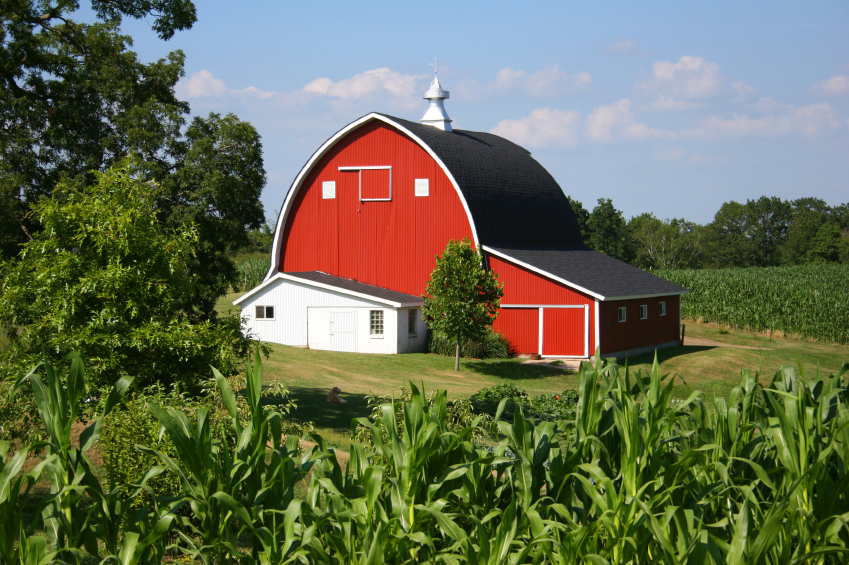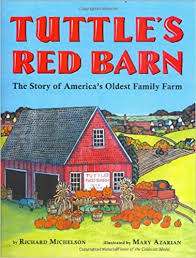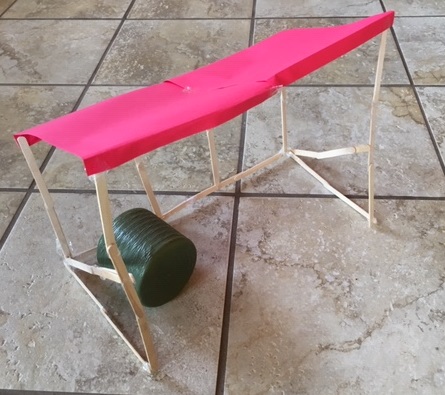 Relevancy and Engagement
ksagclassroom.org
Relevancy and Engagement
ksagclassroom.org
Let's Raise a Barn
Grade Level
Purpose
Students explore the benefits and functions of different types of barns and use problem-solving skills to build a model of a hay barn that meets specific requirements. Grades 3-5
Estimated Time
Materials Needed
Engage:
- Picture of a local barn or Traditional Barn Photo
- Projector
Activity 1: Types of Barns
- Tuttle’s Red Barn by Richard Michelson
- Computers, laptops, smart phones, or tablets, 1 per center
- Where Our Hens Live: Enriched Colony Housing video
- Robotic Dairy Farm Adventure video
- A Field Trip to Ohio Pig Farms video
- The Willing Equine Barn Tour video
- Sheep Farming Sheep Housing video
- Barn Video Viewing Guides, 2 per student
- Venn Diagram, 1 per student
Activity 2: Hay Barn Engineering
- Hay Making at the Joseph Decuis Farm video
- 50 wooden craft sticks
- 2 pieces of 9" X 12" construction paper
- Craft glue
- Tape
- Ruler
- Scissors
Vocabulary
agriculture: the science or practice of farming, including cultivation of the soil for the growing of crops and the rearing of animals to provide food, wool, and other products
barn: a farm building used for storage or housing livestock
farmer: person who owns or manages a farm, cultivates land or crops, or raises animals
hay: grass that has been cut and dried as a feed source for livestock
livestock: farm animals (such as cows, horses, and pigs) that are kept, raised, and used by people
Did You Know?
- The first barns built in America came from design ideas brought over from England by the colonists.1
- In the 1800s, barns were painted red because red paint was the cheapest paint. Red paint contained rust which gave the paint its red color, prevented moss from growing on a wooden barn, and kept barns warmer in the winter by absorbing the sun's rays.2
- Hay is different from straw. Hay is made up of grass, legumes, and other herbaceous plants that have been cut and dried to be used to feed livestock. Straw comes from the stems of cereal grains and is typically used for animal bedding.
Background Agricultural Connections
A barn is an agricultural building. There are many types of barns—poultry barns, dairy barns, pig barns, lambing barns, hay barns, etc.—and each type serves a specific purpose or function. Barns can be used to shelter livestock, to produce a specific farm product, to store farm products and equipment, or for a combination of purposes.
The specific use of a barn determines its design. Production barns are used to produce a specific farm product such as a dairy barn that houses a milking parlor. Storage barns are organized specific to the crops or equipment that will be stored there. Livestock barns shelter animals and protect them from predators, diseases, bad weather, and extreme temperatures. Livestock barns are engineered to meet the needs of specific livestock—dairy cows, beef cattle, turkeys, chickens, sheep, pigs, etc. Access to feed, water, lighting, and fresh air, as well as waste management and sanitation, must be taken into consideration when designing a barn for livestock. General purpose barns are constructed to be used for a combination of purposes.
A barn’s purpose may change over time. A barn that once housed livestock may now house farm equipment, such as tractors, combines, and hay bailers. A farmer may modify a barn to meet the needs of a changing farm. Modern barns utilize high-tech equipment, such as climate control, monitoring systems, robotic assistants, automated feed systems, and sensors, to increase farm efficiency and decrease costs.
There are many benefits to storing hay bales inside a barn. Storing hay in a barn maintains better hay quality, maximizes the nutritional value of the hay, exposes the hay to less moisture and sunlight, decreases the likeliness of spoilage, decreases hay waste, and cuts costs.
Engage

- Project a picture of a local barn or the Traditional Barn Photo onto a large screen. Ask students to identify what it is and the purpose of the building.
- Make a list on the board of the students' ideas about how a barn is used.
- Ask students what color they think of when they think of barns. Answers may vary. Ask students why they think so many barns are red? Explain that, a long time ago, red paint was the cheapest paint. Red paint contained rust, which gave the paint its red color and helped to prevent moss from growing on a wooden barn. Clarify that we see many different colored barns today, but some people still choose to paint them the traditional red color.
- Explain to the students that they will be exploring the many purposes that barns can serve.
Explore and Explain
Activity One: Types of Barns
- Read the story, Tuttle’s Red Barn, by Richard Michelson.
 Discuss with students that barns serve many purposes for farmers. Barns can be used to shelter livestock, to produce a specific farm product, to store farm products and equipment, or for a combination of purposes. In this story, the author takes readers on a journey through time of how one family grew their farm with the changing times and how they adapted the function of their barn to their farming needs.
Discuss with students that barns serve many purposes for farmers. Barns can be used to shelter livestock, to produce a specific farm product, to store farm products and equipment, or for a combination of purposes. In this story, the author takes readers on a journey through time of how one family grew their farm with the changing times and how they adapted the function of their barn to their farming needs. - Explain to the students that one type of barn is a livestock barn. Livestock barns shelter animals and protect them from predators, diseases, bad weather, and extreme temperatures. Livestock barns are engineered to meet the needs of specific livestock—dairy cows, beef cattle, turkeys, chickens, sheep, pigs, etc. Access to feed, water, lighting, and fresh air, as well as waste management and sanitation, must be taken into consideration when designing a barn for livestock.
- Have each student choose two types of livestock barns from the list below:
- Poultry Barn
- Dairy Barn
- Pig Barn
- Horse Barn
- Sheep Barn
- Create six centers. Each center should have a computer, laptop, smart phone, or tablet that is set up to show one of the following videos:
- Poultry Barn: Where Our Hens Live: Enriched Colony Housing
- Dairy Barn: Robotic Dairy Farm Adventure
- Pig Barn: A Field Trip to Ohio Pig Farms
- Horse Barn: The Willing Equine Barn Tour
- Sheep Barn: Sheep Farming Sheep Housing
- Poultry Barn: Where Our Hens Live: Enriched Colony Housing
- Provide each student with two Barn Video Viewing Guides, one for each type of barn they chose. Explain to the students that they are going to view videos that provide information about the two different types of barns they chose. They will use their viewing guides to record their notes about the barns.
- Have the students go to the center with the video about their first barn choice. At the center, the students should view the video and complete their first viewing guide together. Have the students repeat this step with their second barn choice.
- After both viewing guides have been completed, provide each student with a Venn Diagram. Have the students work independently to complete the graphic organizer by using the information from their viewing guides to compare and contrast the two types of barns they chose.
Activity Two: Hay Barn Engineering
- Show the students the video Hay Making at the Joseph Decuis Farm. Students can view the entire process of harvesting, baling, and stacking the hay or only the process of stacking hay bales starting at minute 10:22 and ending at minute 13:02.
- Lead a discussion about the benefits of storing hay bales inside a barn. Integrate the following points into the discussion. Storing hay in a barn:
- maintains better hay quality
- maximizes the nutritional value of the hay
- exposes the hay to less moisture and sunlight
- decreases the likeliness of spoilage
- decreases hay waste
- cuts costs
- Explain to the students that they will design and construct a model of a hay barn that will be used to store 4' x 4' round bales of hay. The tractor that will be used to stack the hay can only stack two bales high. The challenge is for the students to build a barn that maximizes the barn space to fit as much hay inside as possible. For the purposes of the models, 1 inch = 1 foot. During the engineering process, encourage students to measure the interior volume of their barns (length x width x height).
- Explain to the students that farmers are constrained by the amount of money they can spend on building materials to build a barn. The students will also be constrained by the amount of materials they can use to build their barn model.
- Allow students to work independently,
 as partners, or in small groups to design and construct their models. Provide each student, partnership, or group with the following materials:
as partners, or in small groups to design and construct their models. Provide each student, partnership, or group with the following materials:
- 50 wooden craft sticks
- 2 pieces of 9" x 12" construction paper
- Craft glue
- Tape
- Ruler
- Scissors
- To encourage critical thinking, have students consider the following questions before and after the barn models are completed:
- How many sides does your barn have?
- Will you bring the hay through a side or end of the barn?
- Is your barn accessible to a tractor?
- Where is the best location for a barn?
- How many bales will you put in your barn?
- What type of materials would be used to build a real hay barn?
- Can your barn withstand strong winds, ice, and snow?
- When the barn models are completed, determine which barn can fit the most round hay bales stacked two bales high.
Elaborate
-
Have students calculate the approximate amount of hay
 that will fit inside their hay barn model. First, students will need to find their barn volume (length x width x height). Then they find the bale volume, which is the volume of a cylinder (h x π x r2). They would then take the barn volume divided by the bale volume to get an approximate amount of hay that will fit in the barn.
that will fit inside their hay barn model. First, students will need to find their barn volume (length x width x height). Then they find the bale volume, which is the volume of a cylinder (h x π x r2). They would then take the barn volume divided by the bale volume to get an approximate amount of hay that will fit in the barn. -
Have students design a barn that meets the needs of a specific farm animal. Students should consider the following questions when designing their livestock barn:
- How will the animals access food?
- How will the animals access water?
- How will the animals access fresh air?
- How will the animals receive the appropriate amount of light
- How will a proper temperature be maintained within the barn?
- How will the barn be kept clean and sanitary?
Evaluate
After conducting these activities, review and summarize the following key concepts:
- Barns are agricultural buildings that can serve a variety of purposes.
- Barns can be used to shelter livestock, to produce a specific farm product, to store farm products and equipment, or for a combination of purposes.
- The specific use of a barn determines its design.
Sources
- https://www.motherearthnews.com/homesteading-and-livestock/the-history-of-barns-in-america-zbcz1512
- https://tailormadebeef.com/fun-farm-facts-why-are-barns-red/